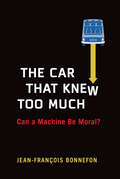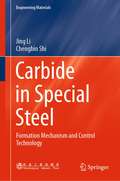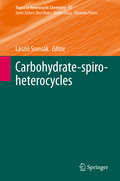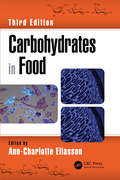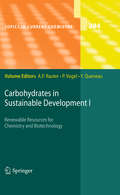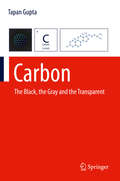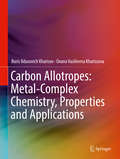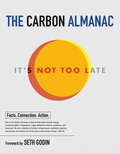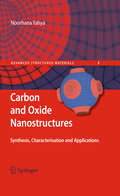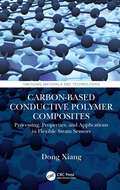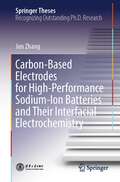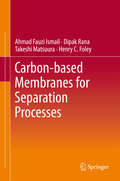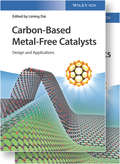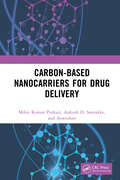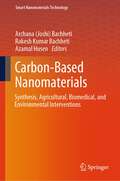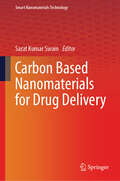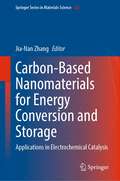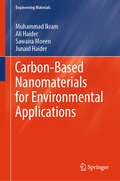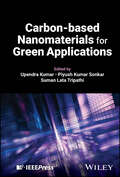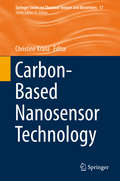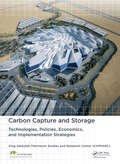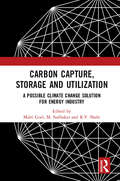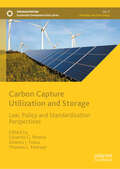- Table View
- List View
The Car That Knew Too Much: Can a Machine Be Moral?
by Jean-Francois BonnefonThe inside story of the groundbreaking experiment that captured what people think about the life-and-death dilemmas posed by driverless cars.Human drivers don't find themselves facing such moral dilemmas as "should I sacrifice myself by driving off a cliff if that could save the life of a little girl on the road?" Human brains aren't fast enough to make that kind of calculation; the car is over the cliff in a nanosecond. A self-driving car, on the other hand, can compute fast enough to make such a decision--to do whatever humans have programmed it to do. But what should that be? This book investigates how people want driverless cars to decide matters of life and death. In The Car That Knew Too Much, psychologist Jean-François Bonnefon reports on a groundbreaking experiment that captured what people think cars should do in situations where not everyone can be saved. Sacrifice the passengers for pedestrians? Save children rather than adults? Kill one person so many can live? Bonnefon and his collaborators Iyad Rahwan and Azim Shariff designed the largest experiment in moral psychology ever: the Moral Machine, an interactive website that has allowed people --eventually, millions of them, from 233 countries and territories--to make choices within detailed accident scenarios. Bonnefon discusses the responses (reporting, among other things, that babies, children, and pregnant women were most likely to be saved), the media frenzy over news of the experiment, and scholarly responses to it. Boosters for driverless cars argue that they will be in fewer accidents than human-driven cars. It's up to humans to decide how many fatal accidents we will allow these cars to have.
Carbide in Special Steel: Formation Mechanism and Control Technology (Engineering Materials)
by Jing Li Chengbin ShiThis book summarizes the research results of carbide control in special steel from the authors. It includes the evolution and control of carbide in special steel in the process of electroslag remelting, rolling, and heat treatment, as well as the effect of alloying treatment (rare earth, magnesium, nitrogen, titanium) as heterogeneous nucleating agent on the carbides in special steel. It helps the readers to understand the formation mechanism and control technology of carbide in special steel deeply for improving the quality of special steel further. The book is useful as a reference for researchers, practitioners, teachers, and engineering management team in the fields of metallurgy and materials.
Carbohydrate-spiro-heterocycles (Topics in Heterocyclic Chemistry #57)
by László SomsákThis volume is devoted to compounds in which the spiro centre is part of a pyranoid or furanoid or an iminosugar ring. The chapters contributed deal with methodological peculiarities of syntheses of natural and artificial sugar derived spirocycles as well as their biological applications and other utilities including marketed drugs. Carbohydrates are ubiquitous molecules in nature and participate in a vast number of biological interactions. Especially their conjugates with practically all kinds of primary and secondary metabolic small molecules (and also biomacromolecules) representing valuable tools for glycobiology research and also lead compounds for drug discovery. While monosaccharides per se appear as heterocycles, their natural conjugates frequently exhibit spiro(hetero)cyclic derivatives, in many cases of high therapeutical relevance. As a consequence, the field of carbohydrate-spiro-heterocycles attracts intense interest from both chemical and biomedical aspects therefore this volume will be of interest for synthetic and medicinal chemists and (glyco)biologists, as well as researchers involved in various biomedical fields.
Carbohydrates in Food
by Ann-Charlotte EliassonCarbohydrates in Food, Third Edition provides thorough and authoritative coverage of the chemical analysis, structure, functional properties, analytical methods, and nutritional relevance of monosaccharides, disaccharides, and polysaccharides used in food. Carbohydrates have become a hot topic in the debate about what to eat. This new edition includes increased treatment of resistant starch, dietary fiber, and starch digestion, especially in relation to different diets, suggesting that carbohydrate consumption should be reduced. New to the Third Edition: Explains how models for starch molecules have been improved recently leading to clearer understanding Discusses the growing interest in new sources of carbohydrates, such as chitosan and fructans, because of their function as prebiotics Features the latest developments on research into dietary fiber and starch digestion Carbohydrates in Food, Third Edition combines the latest data on the analytical, physicochemical, and nutritional properties of carbohydrates, offering a comprehensive and accessible single source of information. It evaluates the advantages and disadvantages of using various analytical methods, presents discussion of relevant physicochemical topics that relate to the use of carbohydrates in food that allow familiarity with important functional aspects of carbohydrates; and includes information on relevant nutritional topics in relation to the use of carbohydrates in food.
Carbohydrates in Sustainable Development II (Topics in Current Chemistry #294)
by Amélia P. Rauter Pierre Vogel Yves QueneauKnoevenagel Reaction of Unprotected Sugars, By M.-C. Scherrmann ; Carbohydrate-Based Lactones: Synthesis and Applications, By N. M. Xavier, A. P. Rauter, and Y. Queneau; Heterogeneously-Catalyzed Conversion of Carbohydrates, By K. De Oliveira Vigier and F. Jérôme; Palladium-Catalyzed Telomerization of Butadiene with Polyols: From Mono to Polysaccharides, By S. Bouquillon, J. Muzart, C. Pinel, and F. Rataboul; Monosaccharides, By J.A. Galbis and M.G. García-Martín; Natural Sources, By L. Weignerová and V. Křen; Synthesis and Applications of Ionic Liquids Derived from Natural Sugars; By C. Chiappe, A. Marra, and A. Mele
Carbon: The Black, the Gray and the Transparent
by Tapan GuptaAll living things contain carbon in some form, as it is the primary component of macromolecules including proteins, lipids, nucleic acids (RNA and DNA), and carbohydrates. As a matter of fact, it is the backbone of all organic (chemistry) compounds forming different kinds of bonds. Carbon: The Black, the Gray and the Transparent is not a complete scientific history of the material, but a book that describes key discoveries about this old faithful element while encouraging broader perspectives and approaches to its research due to its vast applications. All allotropes of carbon are described in this book, along with their properties, uses, and methods of procurement or manufacturing. Black carbon is represented by coal, gray carbon is represented by graphite, and transparent carbon is represented by diamond.
Carbon Allotropes: Metal-Complex Chemistry, Properties and Applications
by Boris Ildusovich Kharisov Oxana Vasilievna KharissovaThis book provides a detailed description of metal-complex functionalized carbon allotrope forms, including classic (such as graphite), rare (such as M- or T-carbon), and nanoforms (such as carbon nanotubes, nanodiamonds, etc.). Filling a void in the nanotechnology literature, the book presents chapters generalizing the synthesis, structure, properties, and applications of all known carbon allotropes. Metal-complex composites of carbons are described, along with several examples of their preparation and characterization, soluble metal-complex carbon composites, cost-benefit data, metal complexes as precursors of carbon allotropes, and applications. A lab manual on the synthesis and characterization of carbon allotropes and their metal-complex composites is included.
Carbon Allotropes and Composites: Materials for Environment Protection and Remediation
by Chandrabhan Verma Chaudhery Mustansar HussainCARBON ALLOTROPES and COMPOSITES The book discusses the most recent developments and trends in the use of carbon allotropes and their composites for environmental restoration and protection including synthesis, characterization and applications. Due to their huge surface area and numerous other distinguishing characteristics, nanostructure materials are widely used in a variety of applications. The production of substrates for better environmental protection and cleanup has been prompted by these qualities. They offer a superior surface for the adsorption of impurities and pollutants that contaminate industrial eff luents, wastewater, air, and soil. These all include a variety of harmful environmental substances such as toxic metals, phenolic compounds, dyes, and other substances that must be treated appropriately before being released into the environment. Composites made of highly efficient and relatively noble carbon allotropes are attracting significant attention for environmental protection and restoration. The use of carbon allotropes offers many benefits, including low cost, low toxicity, simple manufacture, and high efficiency. Therefore, they are ideal replacements for previously established materials. Carbon Allotropes and Composites is one of the first books on carbon allotropes and their composites in environmental protection and remediation, and features a description of CO2 capturing capability. Audience The book is designed for a broad audience working in the fields of materials science and engineering, nanotechnology, energy, environmental chemistry, environmental science, etc.
The Carbon Almanac: It's Not Too Late
by The Carbon Almanac NetworkWhen it comes to the climate, we don&’t need more marketing or anxiety. We need established facts and a plan for collective action.The climate is the fundamental issue of our time, and now we face a critical decision. Whether to be optimistic or fatalistic, whether to profess skepticism or to take action. Yet it seems we can barely agree on what is really going on, let alone what needs to be done. We urgently need facts, not opinions. Insights, not statistics. And a shift from thinking about climate change as a &“me&” problem to a &“we&” problem. The Carbon Almanac is a once-in-a-lifetime collaboration between hundreds of writers, researchers, thinkers, and illustrators that focuses on what we know, what has come before, and what might happen next. Drawing on over 1,000 data points, the book uses cartoons, quotes, illustrations, tables, histories, and articles to lay out carbon&’s impact on our food system, ocean acidity, agriculture, energy, biodiversity, extreme weather events, the economy, human health, and best and worst-case scenarios. Visually engaging and built to share, The Carbon Almanac is the definitive source for facts and the basis for a global movement to fight climate change. This isn&’t what the oil companies, marketers, activists, or politicians want you to believe. This is what&’s really happening, right now. Our planet is in trouble, and no one concerned group, corporation, country, or hemisphere can address this on its own. Self-interest only increases the problem. We are in this together. And it&’s not too late for concerted, collective action for change.
Carbon and Metal Oxides Based Nanomaterials for Flexible High Performance Asymmetric Supercapacitors (Springer Theses)
by Yating HuThis thesis examines electrode materials such as mesoporous carbons, manganese oxides, iron oxides and their nanohybrids with graphene. It also explores several of the key scientific issues that act as the governing principles for future development of supercapacitors, which are a promising class of high-efficiency energy storage devices for tackling a key aspect of the energy crisis. However, critical technical issues, such as the low energy density and reliability, need to be addressed before they can be extended to a wide range of applications with much improved performance. Currently available material candidates for the electrodes all have their disadvantages, such as a low specific capacitance or poor conductivity for transition metal oxide/hydroxide-based materials. This thesis addresses these important issues, and develops a high-performance, flexible asymmetric supercapacitor with manganese oxides/reduced graphene oxide as the positive electrode and iron oxide/reduced graphene oxide as the anode, which delivers a high energy density of 0.056 Wh cm-3.
Carbon and Oxide Nanostructures: Synthesis, Characterisation and Applications (Advanced Structured Materials #5)
by Noorhana YahyaThis volume covers all aspects of carbon and oxide based nanostructured materials. The topics include synthesis, characterization and application of carbon-based namely carbon nanotubes, carbon nanofibres, fullerenes, carbon filled composites etc. In addition, metal oxides namely, ZnO, TiO2, Fe2O3, ferrites, garnets etc., for various applications like sensors, solar cells, transformers, antennas, catalysts, batteries, lubricants, are presented. The book also includes the modeling of oxide and carbon based nanomaterials. The book covers the topics: Synthesis, characterization and application of carbon nanotubes, carbon nanofibres, fullerenes Synthesis, characterization and application of oxide based nanomaterials. Nanostructured magnetic and electric materials and their applications. Nanostructured materials for petro-chemical industry. Oxide and carbon based thin films for electronics and sustainable energy. Theory, calculations and modeling of nanostructured materials.
Carbon-Based Conductive Polymer Composites: Processing, Properties, and Applications in Flexible Strain Sensors (Emerging Materials and Technologies)
by Dong XiangCarbon nanomaterials can transfer their excellent electrical conductivity to polymers while enhancing or maintaining their original mechanical properties. Conductive polymer composites based on carbon nanomaterials are finding increasing applications in aerospace, automotive, and electronic industries when flexibility or lightweight is required. Carbon-Based Conductive Polymer Composites: Processing, Properties, and Applications in Flexible Strain Sensors summarizes recent remarkable achievements in the processing–structure–property relationship of conductive polymer composites based on carbon nanomaterials. It also discusses research developments for their application in flexible strain sensors and novel processing methods like additive manufacturing. Presents the state of the art in conductive composite materials and their application in flexible strain sensors. Uniquely combines the processing, structure, properties, and applications of conductive polymer composites. Integrates theory and practice. Benefits plastics converters who wish to take full advantage of the potential of conductive plastic materials. This book is written for material scientists and engineers researching and applying these advanced materials for a variety of applications.
Carbon-Based Electrodes for High-Performance Sodium-Ion Batteries and Their Interfacial Electrochemistry (Springer Theses)
by Jun ZhangThis book focuses on the development of high-performance carbon electrodes for sodium ion batteries (SIBs). By proposing folded-graphene as the high-density cathode with excellent rate capability, it provides insight into the interplay between oxygen functional groups and folded texture. It also highlights the superiority of ether electrolytes matching with carbon anodes, which are shown to deliver largely improved electrochemical performance. The achievements presented offer a valuable contribution to the carbon-based electrodes in SIBs.
Carbon-based Membranes for Separation Processes
by Takeshi Matsuura Dipak Rana Ahmad Fauzi Ismail Henry C. FoleyThis book provides a significant overview of carbon-related membranes. It will cover the development of carbon related membranes and membrane modules from its onset to the latest research on carbon mixed matrix membranes. After reviewing progress in the field, the authors indicate future research directions and prospective development. The authors also attempt to provide a guideline for the readers who would like to establish their own laboratories for carbon membrane research. For this purpose, detailed information on preparation, characterization and testing of various types of carbon membrane is provided. Design and construction of carbon membrane modules are also described in detail.
Carbon-Based Metal-Free Catalysts, 2 Volumes: Design and Applications
by Liming DaiOffering comprehensive coverage of this hot topic, this two-volume handbook and ready reference treats a wide range of important aspects, from synthesis and catalytic properties of carbon materials to their applications as metal-free catalysts in various important reactions and industrial processes. Following a look at recent advances in the development of carbon materials as carbon-based metal-free catalysts, subsequent sections deal with a mechanistic understanding for the molecular design of efficient carbon-based metal-free catalysts, with a special emphasis on heteroatom-doped carbon nanotubes, graphene, and graphite. Examples of important catalytic processes covered include clean energy conversion and storage, environmental protection, and synthetic chemistry. With contributions from world-leading scientists, this is an indispensable source of information for academic and industrial researchers in catalysis, green chemistry, electrochemistry, materials science, nanotechnology, energy technology, and chemical engineering, as well as graduates and scientists entering the field.
Carbon-Based Nanocarriers for Drug Delivery
by Mihir Purkait Ankush Sontakke AnweshanCarbon-Based Nanocarriers for Drug Delivery enlists the latitudes and advancements in the synthesis processes, functionalization, and applications of carbon-based nanomaterials (CBNs) in targeted drug delivery systems (DDSs). It covers the applicability and suitability of CBNs as nanocarriers for efficient drug delivery application via elucidating the recent advancements in CBNs, their functionalized and innovative derivatives, and the relevant case studies. The book explores the necessity, efficacy, toxicological aspects, and challenges for the application of CBN in targeted DDSs. Some of the features of this book are provided as follows: Provides elaborative description on significance and adaptability of carbon-based nanomaterial in targeted drug delivery for wide ranges of therapeutics Delivers a full-spectrum discussion on drug delivery through carbon-based nanocarriers Explores each carbon-based nanocarrier fundamentally for its drug and gene-delivery-related applications Describes critical discussion on various toxicological effects over the utilization of these nanocarriers Embraces existing as well as novel technologies/methodologies related to the synthesis and functionalization of CBNs, including graphene, graphene oxide, carbon quantum dots, carbon nanotube, fullerene, and smart carbon-based nanocarriers This book is aimed at researchers and graduate students in materials and pharmaceutical engineering, including drug delivery systems.
Carbon-Based Nanomaterials: Synthesis, Agricultural, Biomedical, and Environmental Interventions (Smart Nanomaterials Technology)
by Archana Joshi Bachheti Rakesh Kumar Bachheti Azamal HusenCarbon nanomaterials have several applications, which is driving up scientific research into them. The book showcases the most recent advancements and research discoveries rather than just providing an overview. Each chapter offers authoritative insights into the ever-changing field of carbon-based nanomaterials, as written by top authorities in their respective domains. The book stands out for its persistent focus on real-world application. It is devoted to practical applications and is divided into four sections. The intriguing promise of carbon nanomaterials, their synthesis, and their possible uses set the stage for the adventure. Subsequently, the emphasis shifts to agriculture, where nanomaterials have been shown to improve plant health, fend against illnesses, promote growth and development, and even help detect and remove herbicides. The biomedical part explores the potential toxicological ramifications of these materials while introducing the reader to their ground-breaking role in drug delivery, tissue engineering, and the fight against fungal diseases. Overall, the book provides valuable insights and serves as a comprehensive resource for researchers and scientists across various interdisciplinary subjects.
Carbon Based Nanomaterials for Drug Delivery (Smart Nanomaterials Technology)
by Sarat Kumar SwainThis book comprehensively reviews the incorporation of different types of carbon-based nanomaterials for application in targeted and controlled drug delivery systems. Carbon-based nanomaterials play a vital role as vectors and scaffolds during drug delivery owing to their ultra-small size, non-toxicity, and high water solubility. The chapters in this book present the use of different carbon-based nanomaterials (such as graphene, carbon quantum dots, carbon nanotubes, fullerenes, and carbon nanofibers) into polymeric and polysaccharide-based matrices for the designing of effective drug delivery vehicles which demonstrate superior performance compared to traditional drug delivery systems. In particular, it demonstrates the incorporation of carbon-based nanomaterials into supramolecular drug delivery systems leading to improved drug delivery properties. This book aims to be a reference for researchers and scientists interested in new nanomaterials for drug delivery applications.
Carbon-Based Nanomaterials for Energy Conversion and Storage: Applications in Electrochemical Catalysis (Springer Series in Materials Science #325)
by Jia-Nan ZhangThis book systematically summarizes the advanced development of carbon-based nanomaterials for electrochemical catalysis, and it is comprised of four sections. The first section discusses about the fundamental synthesis, characterization techniques, and catalytic effects on the energy conversion and storage mechanism. The second section elaborately reviews various types of electrocatalytic reactions on carbon-based materials and their performance. The third section focuses on batteries about carbon-based materials with different storage mechanism. And the last one, the following enlightenment in terms of theoretical development and experimental research is provided to the general readers: 1) Precise design and construction of local atomic and electronic structures at the interface of catalysts; 2) Selective activation and directed conversion of carbon-based energy-carrying molecules at the interface; 3) Interaction mechanism and regulation of catalyst solid surface interface properties under environment and external field. This book will be useful for researchers and students who are interested in carbon-based nanomaterials, electrochemical catalysts and energy storage.
Carbon-Based Nanomaterials for Environmental Applications (Engineering Materials)
by Muhammad Ikram Ali Haider Sawaira Moeen Junaid HaiderThis book delves into the incredible potential of carbon-based nanomaterials to solve critical ecological problems. Over the last few decades, substantial research has been conducted on the design and development of advanced nanomaterials for efficient energy storage, wastewater treatment, and antibacterial activities. Carbon-based materials have drawn increasing attention owing to their intriguing physicochemical properties and broad range of promising applications. Learn how these innovative materials are transforming our planet for improvements in areas as diverse as pollution management, purging water, and renewable energy. In this book, the authors briefly introduce the classification of carbon-based materials followed by describing in detail the various synthetic methods classified in two categories, i.e., bottom-up methods and top-down methods. After introducing the synthesis, environmental applications including water purification, air purification, and energy storage and antibacterial activity are explained. Finally, the challenges and opportunities in this promising research area are also proposed. In the current book, carbon-based nanomaterials are addressed in aim for sufficient energy production, wastewater treatment, and as an antibacterial agent. In Chapters 1 and 2, the authors overview the introduction and classifications of carbon-based nanomaterials with its fabrication process. In the next section, the authors review the water purification applications and improvement in the dye degradation activity of carbon-based materials including doping, increasing surface area, and many others. Chapter 4 covers the air purification and energy applications of carbon-based materials along with their experimental and theoretical studies. Moreover, the next chapter explores carbon-based materials for antibacterial activity. This book is specially designed for research purposes and helps the beginners, post-graduate students, and experienced researchers who are working on carbon-based materials and their applications. The book sheds critical light on the ways in which these materials might help make the world a better, more sustainable place.
Carbon-based Nanomaterials for Green Applications
by Upendra Kumar Piyush Kumar Sonkar Suman Lata TripathiGain valuable insight into applying carbon-based nanomaterials to the green technologies of the future The green revolution is the most important technological development of the new century. Carbon-based nanomaterials, with their organic origins and immense range of applications, are increasingly central to this revolution as it unfolds. There is an urgent need for an up-to-date overview of the latest research in this ever-expanding field. Carbon-Based Nanomaterials for Green Applications meets this need by providing a brief outline of the synthesis and characterization of different carbon-based nanomaterials, including their historical backgrounds. It proceeds to move through each major category, outlining properties and applications for each. The result is an essential contribution to a huge range of sustainable and renewable industries. With contributions from a global list of distinguished writers, the book includes: Discussion of nanomaterial applications in fields from drug delivery to biomedical technology to optics Analysis of nanomaterial categories including graphene, fullerene, mesoporous carbon, and many more Separate chapters describing aspects of supercapacitors, solar cells, and fuel cells Carbon-Based Nanomaterials for Green Applications is ideal for scientists and researchers working in nanotechnology, life sciences, biomedical research, bioengineering, and a range of related fields.
Carbon-Based Nanosensor Technology (Springer Series on Chemical Sensors and Biosensors #17)
by Christine KranzCarbon nanomaterials have gained relevance in chem/bio sensing applications owing to their unique chemical, mechanical, electrical, and thermal characteristics. Written by leading experts in the field, this book discusses selected, state-of-the art carbon-based nanomaterials, including nanodiamonds, graphene nanodots, carbon nanopores, and nanocellulose. It presents examples of chem/bio sensing applications ranging from biomedical studies, such as DNA sequencing and neurotransmitter sensing, to heavy-metal detection in environmental monitoring scenarios, and reviews the unique properties of carbon-based nanomaterials with respect to targeted sensing applications. Further, it highlights exciting future applications. Providing comprehensive information for practitioners and scientists working in the field of carbon nanomaterial technologies and their application, it is also a valuable resource for advanced students of analytical chemistry, biochemistry, electrochemistry, materials science, and micro-/nanotechnology and -sensing.
Carbon Capture and Storage: Technologies, Policies, Economics, and Implementation Strategies
by King Abdullah Petroleum Studies Saud M. Al-Fattah Murad F. Barghouty Bashir O. DabbousiThis book focuses on issues related to a suite of technologies known asCarbon Capture and Storage (CCS), which can be used to capture and store underground large amounts of industrial CO2 emissions. It addresses how CCS should work, as well as where, why, and how these technologies should be deployed, emphasizing the gaps to be filled in terms o
Carbon Capture, Storage and Utilization: A Possible Climate Change Solution for Energy Industry
by Malti Goel M. Sudhakar R. V. ShahiCarbon capture and storage (CCS) is among the advanced energy technologies suggested to make the conventional fossil fuel sources environmentally sustainable. It is of particular importance to coal-based economies. This book deals at length with the various aspects of carbon dioxide capture, its utilization and takes a closer look at the earth processes in carbon dioxide storage. It discusses potential of Carbon Capture, Storage, and Utilization as innovative energy technology towards a sustainable energy future. Various techniques of carbon dioxide recovery from power plants by physical, chemical, and biological means as well as challenges and prospects in biomimetic carbon sequestration are described. Carbon fixation potential in coal mines and in saline aquifers is also discussed. Please note: This volume is Co-published with The Energy and Resources Institute Press, New Delhi. Taylor & Francis does not sell or distribute the Hardback in India, Pakistan, Nepal, Bhutan, Bangladesh and Sri Lanka
Carbon Capture Utilization and Storage: Law, Policy and Standardization Perspectives (Sustainable Development Goals Series)
by Eduardo G. Pereira Alberto J. Fossa Thomas L. MuinzerThis book delves into how carbon capture, utilization, and storage (CCUS) technologies might help accelerate the worldwide transition to sustainable energy while meeting Paris Agreement targets. This comprehensive handbook examines how governments, businesses, and society may effectively implement CCUS programs to cut carbon emissions and promote economic development. The book begins with basic ideas and exposes readers to CCUS technologies and their critical role in reaching net-zero emissions by 2050. It investigates successful CCUS installations from various countries and suggests prospects for host governments and energy firms. The book combines technical innovation and carbon neutrality initiatives, while also addressing regulatory frameworks and normative factors that are critical for wider acceptance. With climate change mitigation at its core, the book offers pragmatic recommendations for policymakers and industry leaders on how to employ CCUS for sustainable development, making it a valuable resource for environmental researchers, energy professionals, and policymakers working toward a low-carbon economy.
